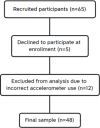Association of sedentary behavior and physical activity with occurrence of signs and symptoms in participants of a cardiac rehabilitation program
- PMID: 39349610
- PMCID: PMC11442860
- DOI: 10.1038/s41598-024-74199-6
Association of sedentary behavior and physical activity with occurrence of signs and symptoms in participants of a cardiac rehabilitation program
Abstract
Sedentary behavior (SB) is associated with health impairments, while physical activity (PA) has been a protective factor. It is unclear whether SB and PA are associated with occurrence of signs and/or symptoms (SS) during cardiac rehabilitation program (CRP) exercise sessions. The objective was to evaluate the association between SB and PA with occurrence of SS. Was included 48 patients from a CRP program (64.7 ± 10.4 years-old). Daily time and % of time of SB and weekly time in moderate-to-vigorous-intensity [MVPA], % of MVPA time, steps/day, and steps/minute were accelerometer-measured. Patients were followed-up during 24 CRP sessions, for accompaniment of SS. Age, sex, and comorbidities (hypertension, diabetes, dyslipidemia, obesity) were covariates. Log-transformed values of SB, MVPA and steps/day were also analyzed. As results, 43.7% (n = 21) of participants presented occurrence of signs, 62.5% (n = 30) presented occurrence of symptoms, and 81.2% (n = 39) present occurrence of SS. In fully adjusted model, % of time in MVPA (β: -0.449,p = 0.045) and steps/minute (β: -0.244,p = 0.026) were inversely associated with occurrence of symptoms. No association was observed between SB and PA and occurrence of signs. The occurrence of symptoms and SS among CRP participants was directly associated with SB and inversely associated with variables of PA.
Keywords: Cardiac Rehabilitation; Cardiovascular diseases; Exercise; Sedentary behavior, Signs and symptoms.
© 2024. The Author(s).
Conflict of interest statement
The authors declare no competing interests.
Figures
Similar articles
-
Objectively Measured Changes in Physical Activity and Sedentary Behavior in Cardiac Rehabilitation: A PROSPECTIVE COHORT STUDY.J Cardiopulm Rehabil Prev. 2018 Nov;38(6):E5-E8. doi: 10.1097/HCR.0000000000000334. J Cardiopulm Rehabil Prev. 2018. PMID: 29952812
-
Associations of emotional/behavioral problems with accelerometer-measured sedentary behavior, physical activity and step counts in children with autism spectrum disorder.Front Public Health. 2022 Oct 10;10:981128. doi: 10.3389/fpubh.2022.981128. eCollection 2022. Front Public Health. 2022. PMID: 36299767 Free PMC article.
-
Associations Between Parent Self-Reported and Accelerometer-Measured Physical Activity and Sedentary Time in Children: Ecological Momentary Assessment Study.JMIR Mhealth Uhealth. 2020 May 19;8(5):e15458. doi: 10.2196/15458. JMIR Mhealth Uhealth. 2020. PMID: 32348283 Free PMC article.
-
Effects of two behavioral cardiac rehabilitation interventions on physical activity: A randomized controlled trial.Int J Cardiol. 2018 Mar 15;255:221-228. doi: 10.1016/j.ijcard.2017.12.015. Int J Cardiol. 2018. PMID: 29425564 Clinical Trial.
-
Accelerometer-measured physical activity and sedentary behavior in Chinese children and adolescents: a systematic review and meta-analysis.Public Health. 2020 Sep;186:71-77. doi: 10.1016/j.puhe.2020.07.001. Epub 2020 Aug 9. Public Health. 2020. PMID: 32784098
References
-
- Carter, S., Hartman, Y., Holder, S., Thijssen, D. H. & Hopkins, N. D. Sedentary behavior and cardiovascular disease risk: mediating mechanisms. Exerc. Sport Sci. Rev.45(2), 80–86 (2017). - PubMed
MeSH terms
Grants and funding
LinkOut - more resources
Full Text Sources
Medical
Research Materials
Miscellaneous



